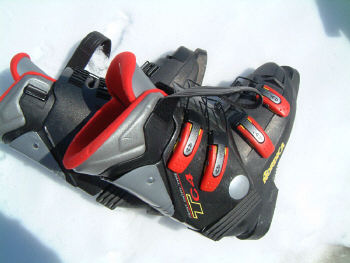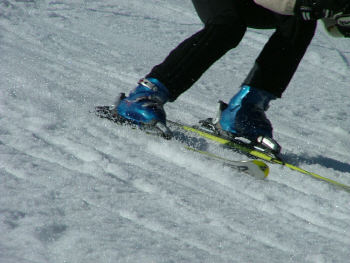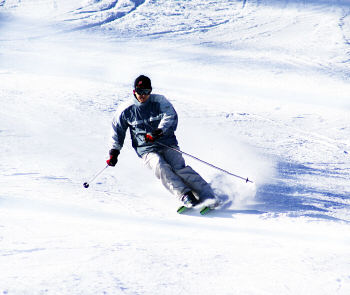Choosing the Right Ski Boots
by Luther Mardock
 Most skiers, even occasional recreational skiers, recognize the benefits of owning your own equipment over renting at the slopes. Ski boots are a highly specialized type of footwear designed to specific parameters to suit various types of skiers and skiing. The type of ski boot you need will depend on a number of factors including: your level of experience and technical skill as a skier, the type of skiing you do, where you ski, and what your budget is.
Most skiers, even occasional recreational skiers, recognize the benefits of owning your own equipment over renting at the slopes. Ski boots are a highly specialized type of footwear designed to specific parameters to suit various types of skiers and skiing. The type of ski boot you need will depend on a number of factors including: your level of experience and technical skill as a skier, the type of skiing you do, where you ski, and what your budget is.
Selecting a Boot for Different Levels of Experience
Beginning, intermediate, recreational and occasional skiers will want a ‘looser’ boot. It is important to note this does not refer to the fit of the boot; the boot should be fitted according to the guidelines that will be discussed below. It refers only to the flexibility of the boot. A beginning level boot is more forgiving, but sacrifices performance. As you gain experience you may want to consider moving up to a performance-oriented boot.
Experienced skiers will likely find the lack of sensitivity in an entry level boot unsatisfying, especially if you are used to a higher level of performance.
Fitting a Boot
 As is the case with any type of sports footwear, running shoes, court shoes, or hiking boot, the fit of a ski boot is of primary importance. The fitting of a ski boot is a technical procedure that is best done by a certified professional at a reputable ski shop. Incorrectly fitted ski boots can be uncomfortable at best, and dangerous at their worst. If there is not an experienced boot fitter available when you arrive at the store, or if you are shopping online, there are some basic guidelines you can follow.
As is the case with any type of sports footwear, running shoes, court shoes, or hiking boot, the fit of a ski boot is of primary importance. The fitting of a ski boot is a technical procedure that is best done by a certified professional at a reputable ski shop. Incorrectly fitted ski boots can be uncomfortable at best, and dangerous at their worst. If there is not an experienced boot fitter available when you arrive at the store, or if you are shopping online, there are some basic guidelines you can follow.
- Find your approximate ski boot size. Ski boots are usually sold in what is called Mondo Point Sizing, which is basically just the size of your foot in centimeters. Shops should have a conversion guide, or break out your trusty metric ruler. There are also conversion guides available on the web.
- Your size is just a starting point. When you get the boot, take out the lining. The store assistant should be able to help you with this. Put your foot in the shell and move your toes all the way to the front. Check the distance between your heel and the back of the shell, there should be less than one inch of space. Check the shell width as well, if it is too wide the lining of the boot may not conform correctly to the shape of your boot.
- When you try on the boot put on socks designed for skiing to ensure correct sizing. A quality sock will be either wool or a synthetic material designed to wick moisture away from the foot.
- Remember boots will be sized smaller than you expect. Your toe will touch the front of the boot. The lining of the boot will compress as well, giving your toes additional room.
- An expert fitting can take more than an hour. The tightness of a new boot may cause your foot to tingle or ‘fall asleep.’ Try the boot on multiple times after allowing your foot to return to normal.
- You should try on at least three different brands of boots. Ski boots are designed around lasts, which are wooden models of feet. Each manufacturer’s boot will have characteristic volume in certain areas of the boot. You may find for example, that you will need different sizes of boot for each different brand of boot you try on.
Boot Components
 There are a variety of other factors to keep in mind when buying boots. Each brand of boot will have variations in the components and features.
There are a variety of other factors to keep in mind when buying boots. Each brand of boot will have variations in the components and features.
Shell
The shell of the alpine boot is made of some type of plastic or polymer. The type of plastic may vary between manufacturers. The shell is the basic support structure of the boot. It is what will transfer the energy from your foot to the ski. As noted above, beginning and intermediate boots will have more flexible shells. The shell should be made of high impact plastic that is waterproof and durable.
Lining
The lining of the boot provides padding and warmth for the foot. The fill material will vary. Some common types are Thermo-fit and Sensi-fit. Some higher end boots may have custom or air fit liners. The lining is designed to ‘learn’ the shape of your foot. As your wear the boots the lining will compress, conforming to your foot. It will also, however, continue to compress over time, so with use your boot may begin to feel larger than when it was new.
Entry Point
You may find boots that have different entry points. It is still possible to buy what are called ‘rear-entry’ boots, which were popular in the past with beginning skiers due the relative ease with which they can be put on. However, advances in top-entry boots have for the most part made them obsolete.
Flexibility Adjustment
Some boots will have a dial or switch at the back that adjusts the flexibility of the boot. A boot, like any other material, performs differently depending on temperature. In the relative warmth of a ski shop a boot may feel more flexible than in the below freezing temperatures on the slopes. The dial or switch will allow you to compensate for these changes. You may also find what is called a ski walk function. This is designed to make it easier to walk in the boot. However, there is a sacrifice in the stability of the boot for this feature.
Remember, the best way to buy your boots is to have a professional fitter assist you with the process. Years of experience and ever-changing technological enhancements allow them provide invaluable service. Do some basic online research before you go to a fitter, and plan on spending some time in the shop. Don’t be afraid to try different shops as they may carry different brands of boots.
Luther Mardock is an educator and free-lance writer in Lincoln, Nebraska who enjoys providing informative tips to consumers when shopping for boots. He has backpacked throughout the US, Europe and Africa.